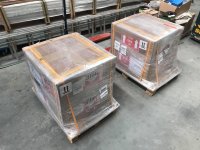I've been looking for a reference to explain the moment when capacitor design went from a capacitor to a "super capacitor". So far it "looks like" it was the moment when they went from jobs like voltage ripple smoothing to actually storing energy, and being designed from the ground up to do that. Perhaps when "double sided" capacitors were designed? which dramatically improved the capacity, but don't seem to change any other metric.
The first capacitors I began reading about was the low-ESR 50V units that we added to 12S "44V" RC motor systems, to keep the expensive ESCs from popping.
https://endless-sphere.com/forums/viewtopic.php?t=22194&start=45
Those are roughly the volume of my little finger, and have 1,000 uF. Since one Farad is (*Googles furiously) 1,000,000 uF, and...The Maxwell "D-cell" 350F super capacitors I have are roughly ten times the physical volume, but...their electrical energy capacity is...100,000 more per Farad, then they are...350,000 times more capacity. So...knock off one zero to divide the D-cell volume by a tenth (to equalize volumes), and...The super capacitor has 35,000 more energy per unit-of-volume than a capacitor that is designed for the normal jobs capacitors used to do.
That being said, when comparing super capacitors to batteries, I recently saw many you tubes of cars being started by super caps, and...since SCs drain down over time, I also saw hybrid packs with 4S LiFePO4 + SCs. One video shows a fully charged 6S 350F super cap bank (no lithium added), he unplugged the spark and fuel relay, then cranked-over the 4-cylinder engine. He had shown on some cheap measuring devices that this car started with a half-second peak of 200A, and a continuous 100A to keep going. It ran for about 30 seconds at 100A on the SCs alone.
100A is pretty awesome for an ebike (IMHO), but...30 seconds is very short range (although, not bad for six D-cells). On the other hand, most of the videos were for cars in ultra-cold climates where lead-acid sags, even when new and fully-charged.
Here's one tech observation. A common strategy to increase capacity (among several strategies), is to increase the collector area per volume, and one way to do that is to use the thinnest possible separator sheets. However, the thinner the separator, the lower the break-down voltage is, so...high-Farad SCs are typically low voltage. The Maxwells are 2.7V and the Amperics are 3.0V
Luke has been an advocate for lowering typical system voltages, and emphasizing amps to get the target watts. It would be interesting to see a high-powered E-moto system as low as 13S / 48V with SC's added to handle the acceleration peaks, and the battery designed for best capacity (or failing that, maybe an E-scooter?). Many E-scooters start out as 48V, and are boosted to 72V when the lead acid dies and the owner swaps to lithium. What if he swapped to a higher KV motor (low turn-count) and added super caps to handle amp peaks?


